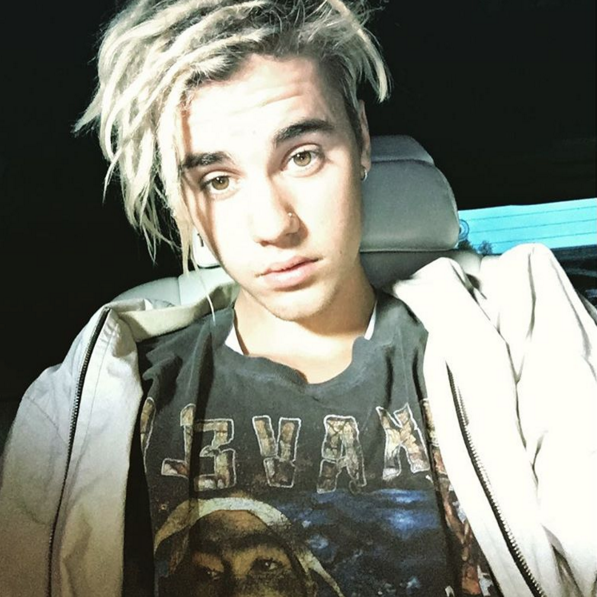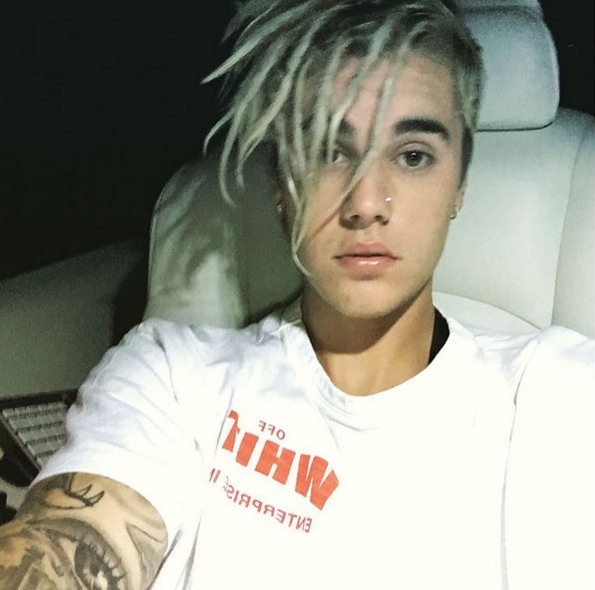Guess Justin Bieber Didn’t Get That Memo on Dreadlocks

Justin Bieber revealed his new ’do on Sunday. (Photo: Instagram)
Not since last year’s media frenzy over the tale of Rachel Dolezal has the idea of “cultural appropriation” been so front-and-center. That time, if you recall, it centered on the controversial white NAACP chapter president and African-history professor who claimed she identified as black. This time, we have a hairstyle to thank: dreadlocks, specifically on white people, first on San Francisco University student Cory Goldstein, who was confronted about his hair by a black woman in a video that went viral last week, and now on the head of none other than Justin Bieber.
“Why,” was the only caption the pop star offered along with the first of four photos of his dreads, posted Sunday on Instagram. But the responses — more than 52,000 comments on that first pic and just as many on the most recent — were more loquacious, with folks weighing in on his new look and arguing about whether the Biebs even “deserved” dreadlocks, not a traditionally Caucasian domain.
Related: Spar Over Dreadlocks at San Francisco State University Goes Viral
He reportedly defended his new look backstage at the iHeartRadio Music Awards Sunday night, telling rapper Big Sean “[People say] you wanna be black and all that stuff, I’m like ‘It’s just my hair.’”
Reactions to Bieber’s Instagram pics have been all over the map. “Locks aren’t a look, they’re a lifestyle,” said one Instagram commenter, while one of many anti-Bieb tweets has announced, “I’m keeping Justin blocked until he takes out his dreads.”

Photo: Instagram
Another Instagram comment — from a white woman with dreadlocks — argued that anyone was welcome to take part, as long as they understood what they were doing. “Dreadlocks are not for only one ethnicity of people to have… But they are absolutely a cultural thing,” she noted. “No one should be hated on simply for being a white dreadhead, even if it’s Justin Bieber who I can’t stand. What matters is that you know and respect the history and meaning behind them.”
Related: Tyra Banks and the Roots of Dreadlocks
Many, of course, disagree that it’s ever okay — including the woman in the recent SFU video, who contended that dreadlocks belong to “[her] culture.”
Indeed, when Tyra Banks revealed her new dreadlocks on Instagram in March, the public response was overwhelmingly positive — unlike when Miley Cyrus unleashed her own while hosting the MTV Video Music Awards last year, and was accused of appropriating the look. The same has been said of pop stars taking on various aspects of black hip-hop culture over the years by opting for such looks as cornrows (sported by Bieber in January) and grills (hi, Madonna), as well as looks from other cultures, including henna tattoos (recently worn, in the face of some criticism, by Beyoncé) and bindis of South Asia — the latter of which recently inspired a social media movement and hashtag, #reclaimthebindi.
“The line between cultural appropriation and cultural exchange is always going to be blurred but here’s the thing: appropriation occurs when a style leads to racist generalizations or stereotypes where it originated but is deemed as high-fashion, cool, or funny when the privileged take it for themselves,” explained 16-year-old actress Amandla Stenberg in a 2015 video post (seen below, and viewed nearly 2 million times) for Hype Hair Magazine — kind of like how Zendaya was said to look like she “smells like patchouli oil or weed” when she wore dreadlocks on the red carpet last year.
It can be tricky to draw the line between cultural theft and borrowing, but it’s possible, according to Susan Scafidi, founder and academic director of the Fashion Law Institute at Fordham Law School and author of Who Owns Culture? Appropriation and Authenticity in American Law.
“My guideline for separating cultural appropriation from misappropriation comes back to three S’s: source, significance (or sacredness), and similarity,” she tells Yahoo Beauty. “Is the source culture particularly vulnerable or historically oppressed? Does the cultural product in question or its use have special significance to the source community? And is the appropriation a direct copy or just inspired by the source community?”
Dreadlocks, she continues, have religious significance in “a number of global historical and cultural contexts,” such as Ancient Greeks, Egyptians, Aztecs, and Africans (including the Masai tribesmen, of Kenya, who originated the look), as well as early Christians, Vikings, Hindu yogis, and holy men in India. But the term dreadlock, notes CNN, comes from the Rastafarian culture, which considers “the locks a sign of their African identity and a religious vow of their separation from what they call Babylon, a historically white-European imperialist structure that has oppressed blacks and other people of color since way back when, according to Migrations in History.”
Says Bertram Ashe — dreadlock wearer, University of Richmond English professor, and author of Twisted: My Dreadlock Chronicles — “Dreadlocks are definitely a flashpoint, no question about it.” He tells Yahoo Beauty that discussions about appropriation are vitally important but basically believes everyone gets to wear their hair as they wish. Regarding the woman in the SFU video, “The problem, is I don’t know how easy it is for her to say ‘that’s my culture’ when you talk to Rastafarians and they’re looking side-eyed at African Americans. There’s always going to be someone who feels robbed,” he says. “So I just don’t think it’s as simple as ‘That’s my culture.’”
Still, Ashe can “appreciate that people feel fantastically annoyed” by folks like Bieber wearing locks. And according to Scafidi, the long-lasting legacy of slavery has given black hairstyles particular cultural and political weight in this country. “As recently as 2014, new U.S. Army guidelines for women’s hairstyles were criticized as unduly restricting African-American servicewomen and had to be quickly revised,” she says. “Justin Bieber’s dreads or Kendall Jenner’s braids can seem less like aesthetic solidarity and more like a superficial style statement that ignores complex cultural meaning.”
That was how rapper Azealia Banks felt about white hip-hop star Iggy Azalea when Azalea stayed silent around police brutality in 2014. “I have a problem when you’re trying to say that it’s hip-hop … It’s like a cultural smudging,” she said in an interview. “All it says to white kids is, like, oh yeah, you’re great, you’re amazing, you can do whatever you put your mind to, and it says to black kids, ‘You don’t have s***. You don’t own s***, not even the s*** you created for yourself.’ And it makes me upset.”
Further, “there is no Supreme Court of Culture or Miss Manners of Misappropriation,” notes Scafidi. “Instead, in today’s world we’re having a broad conversation around culture, facilitated by social media and the Internet, which allows everyone to have a voice. Culture is fluid and evolving, and online debate can help everyone understand the community significance of particular cultural products — including hairstyle, tattoos, piercings, and even body paint and makeup — so that we can move toward social norms that respect both cultural values and personal expression.”
Read This Next: First On-Demand Beauty Service for Women of Color Launching
Let’s keep in touch! Follow Yahoo Beauty on Facebook, Twitter, Instagram, and Pinterest.


